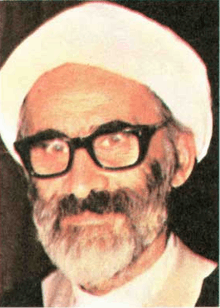Ali Golzadeh Ghafouri
Ali Golzadeh Ghafouri (14 May 1923[2] – 1 January 2010) (Persian: علی گلزاده غفوری) was an Iranian Shia cleric and religious progressive politician.[3]
Ali Golzadeh Ghafouri | |
|---|---|
 | |
| Member of Iranian Parliament | |
| In office 28 May 1980 – 28 May 1984 (Abstention since 10 June 1981) | |
| Constituency | Tehran, Rey and Shemiranat |
| Majority | 1,336,435 (62.6%) |
| Member of Assembly of Experts for Constitution | |
| In office 15 August 1979 – 15 November 1979 | |
| Constituency | Tehran Province |
| Majority | 1,560,970 (61.5%) |
| Personal details | |
| Born | 14 May 1923 Qazvin, Iran |
| Died | 1 January 2010 (aged 86) Tehran, Iran |
| Nationality | Iranian |
| Alma mater | Sorbonne[1] |
Political career
He ran as an independent candidate in the 1979 Iranian Constitutional Convention election. He criticized the conventional notions of private property by the establishment and enjoyed support by the People's Mujahedin of Iran, along with Mahmoud Taleghani.[1] He was among the members of the post-revolutionary constituent assembly opposing to inclusion of Guardianship of the Islamic Jurist in the constitution.[4][5]
In 1980, he was elected to the parliament, and was considered sympathetic to the Freedom Movement of Iran and the parliamentary opposition to the ruling Islamic Republican Party.[6]
He left politics in 1981 and died in January 2010.[3]
Electoral history
| Year | Election | Votes | % | Rank | Notes |
|---|---|---|---|---|---|
| 1979 | Assembly of Experts | 1,560,970 | 61.5 | 4th | Won[7] |
| 1980 | Parliament | 1,336,435 | 62.6 | 10th | Won[8] |
Personal life
All three his children and his son-in-law were members of the People's Mujahedin of Iran (MEK) and were executed by the authorities.[9]
References
- Ervand Abrahamian (1989), "To The Masses", Radical Islam: the Iranian Mojahedin, Society and culture in the modern Middle East, 3, I.B.Tauris, p. 193, ISBN 9781850430773
- http://www.pezhvakeiran.com/page1.php?id=18938
- "Selected Headlines", Tehran Bureau, PBS, 3 January 2010, retrieved 1 November 2017
- Said Saffari (1993), "The Legitimation of the Clergy's Right to Rule in the Iranian Constitution of 1979" (PDF), British Journal of Middle Eastern Studies, Taylor & Francis, Ltd, 20 (1): 64–82, doi:10.1080/13530199308705571
- Yvette Hovsepian-Bearce (2016), The Political Ideology of Ayatollah Khamenei, Routledge, p. 23, ISBN 978-1-315-74835-1
- Houchang E. Chehabi (1990). Iranian Politics and Religious Modernism: The Liberation Movement of Iran Under the Shah and Khomeini. I.B.Tauris. pp. 283, 288. ISBN 1850431981.
- Ervand Abrahamian (1989), "To The Masses", Radical Islam: the Iranian Mojahedin, Society and culture in the modern Middle East, 3, I.B.Tauris, p. 195, Table 6, ISBN 9781850430773
- Ervand Abrahamian (1989), "The Majles elections (February–May 1980)", Radical Islam: the Iranian Mojahedin, Society and culture in the modern Middle East, 3, I.B.Tauris, pp. 203–205, Table 8, ISBN 9781850430773
- "Tehran bombing kills one, wounds two", United Press International, 12 September 1982, retrieved 1 November 2017